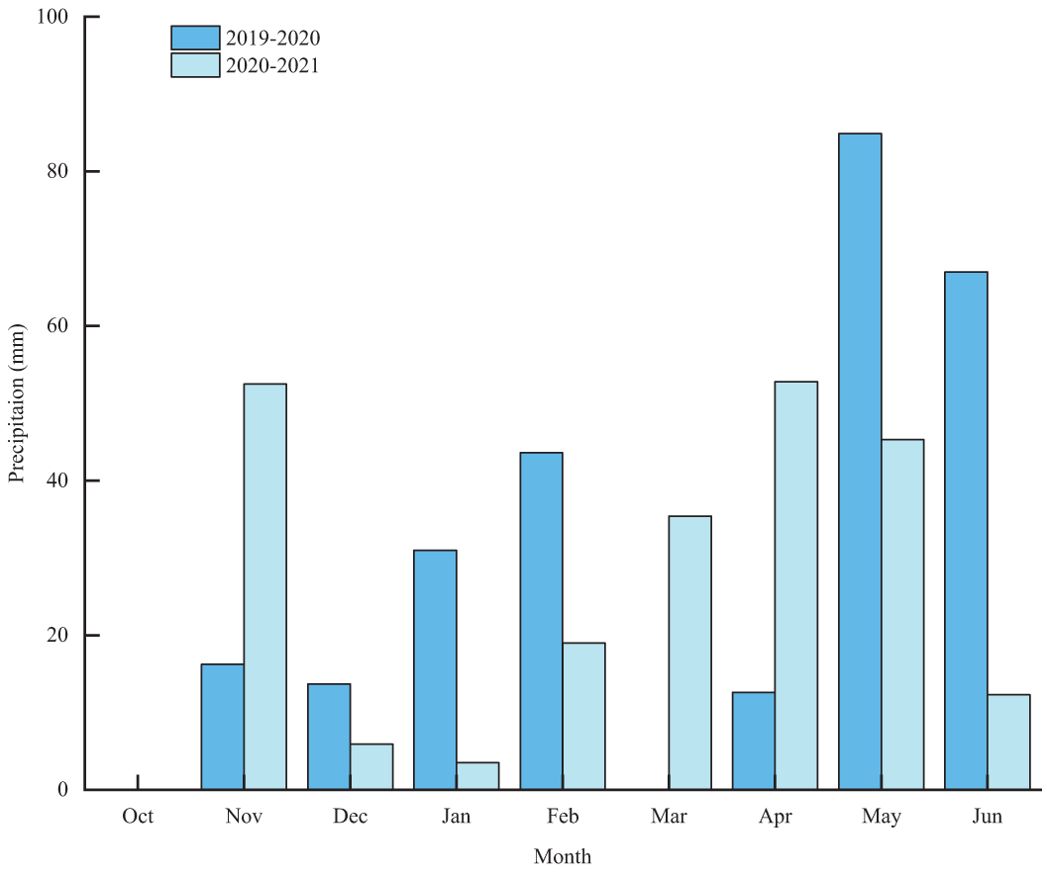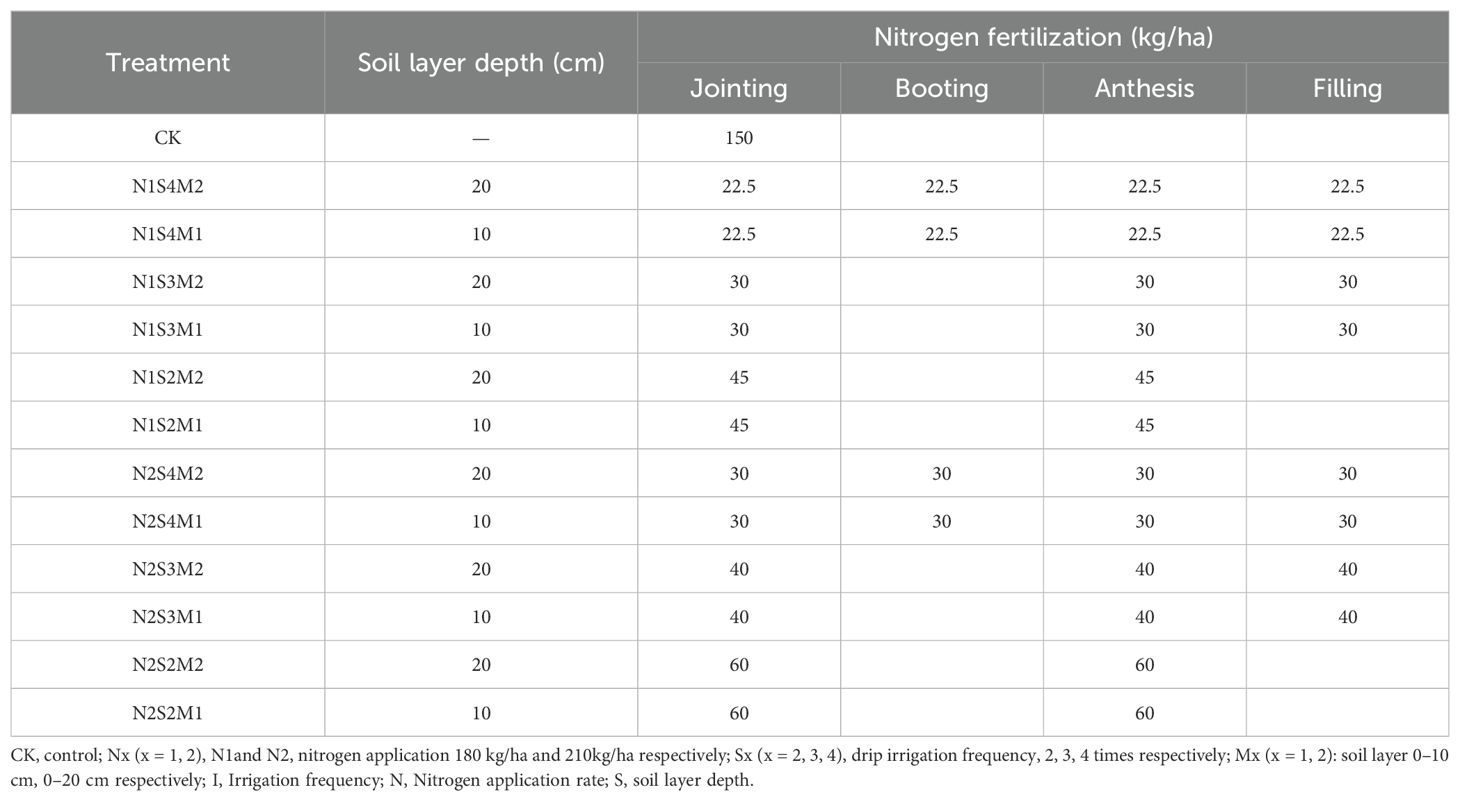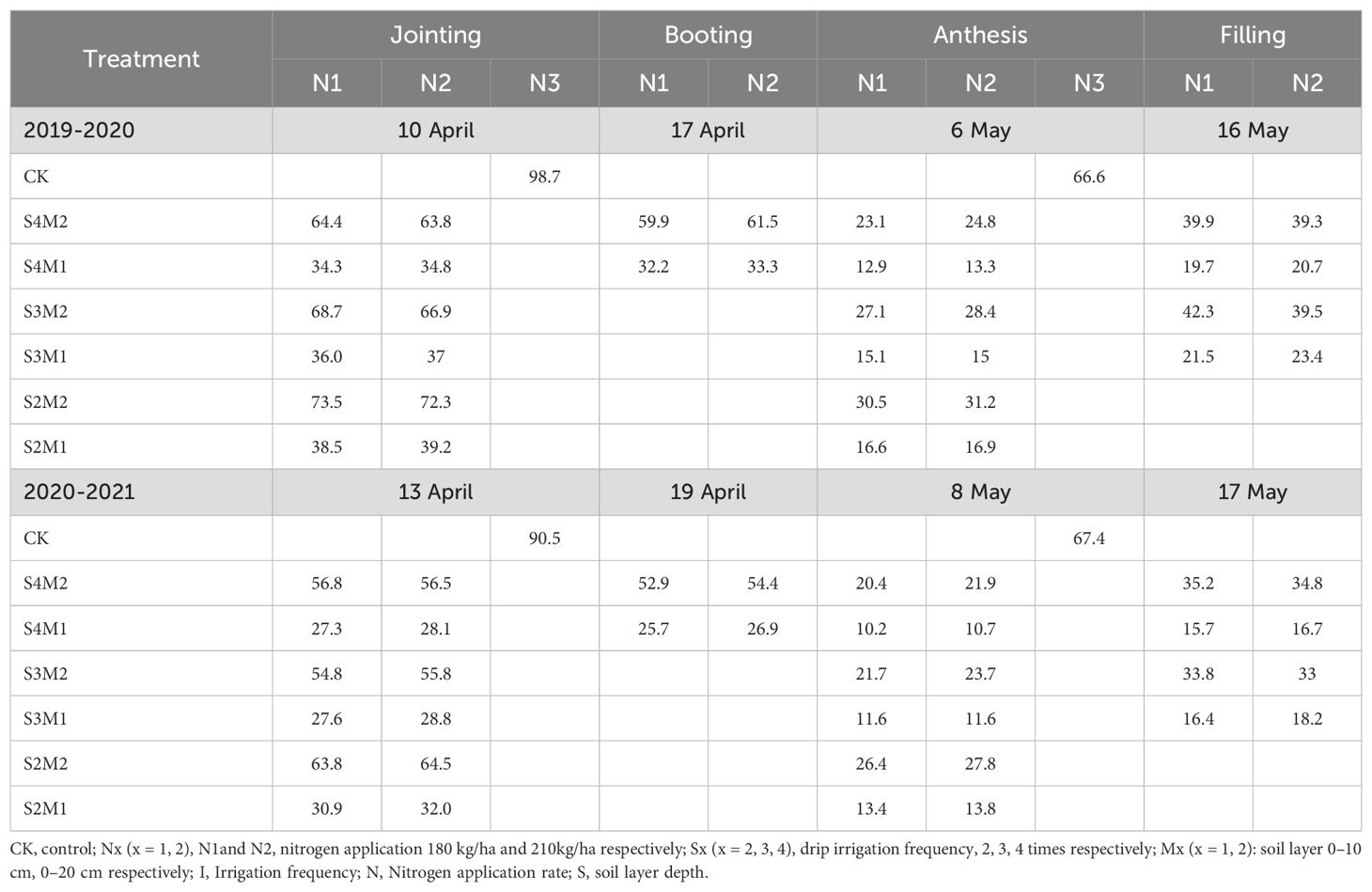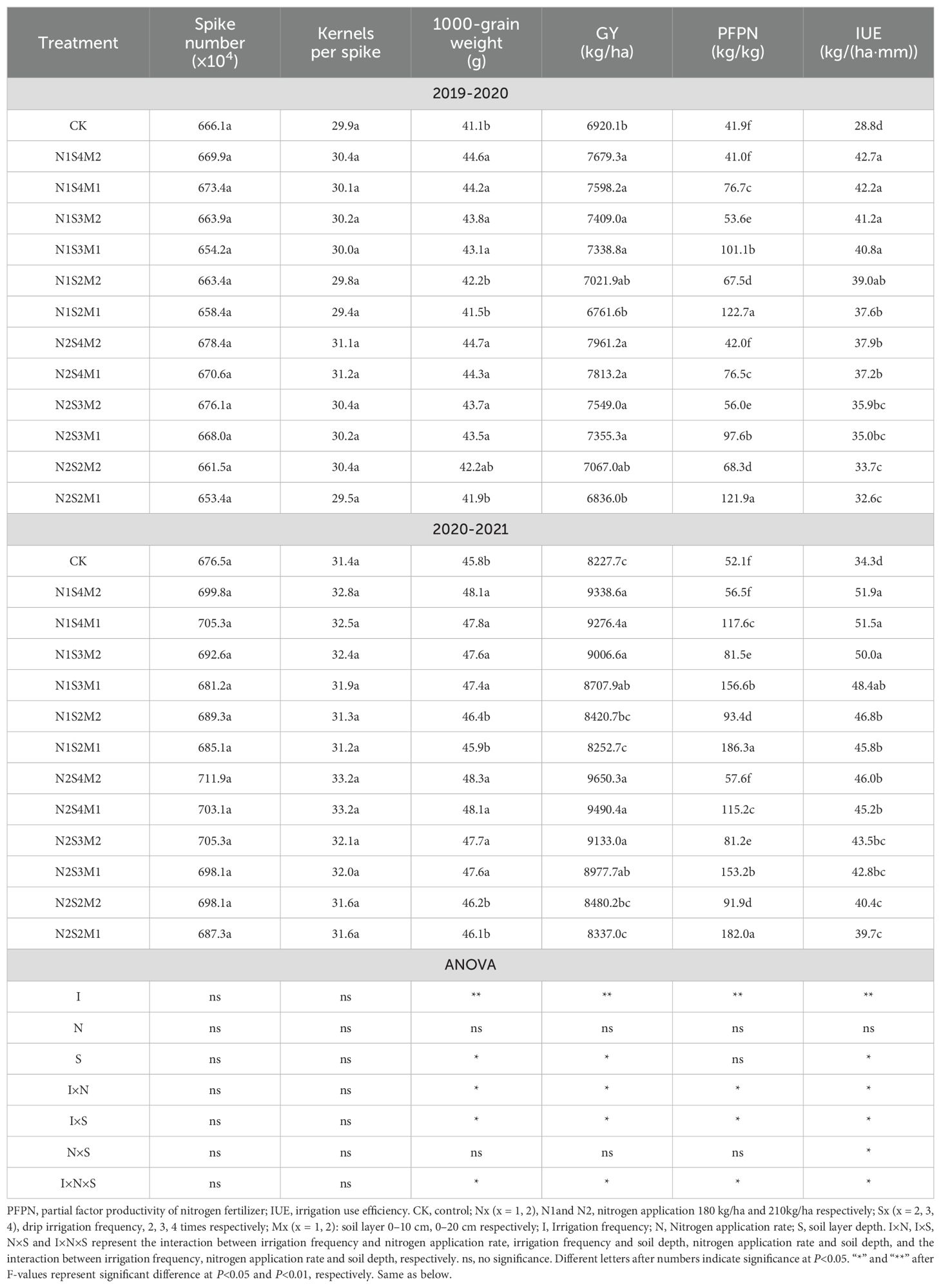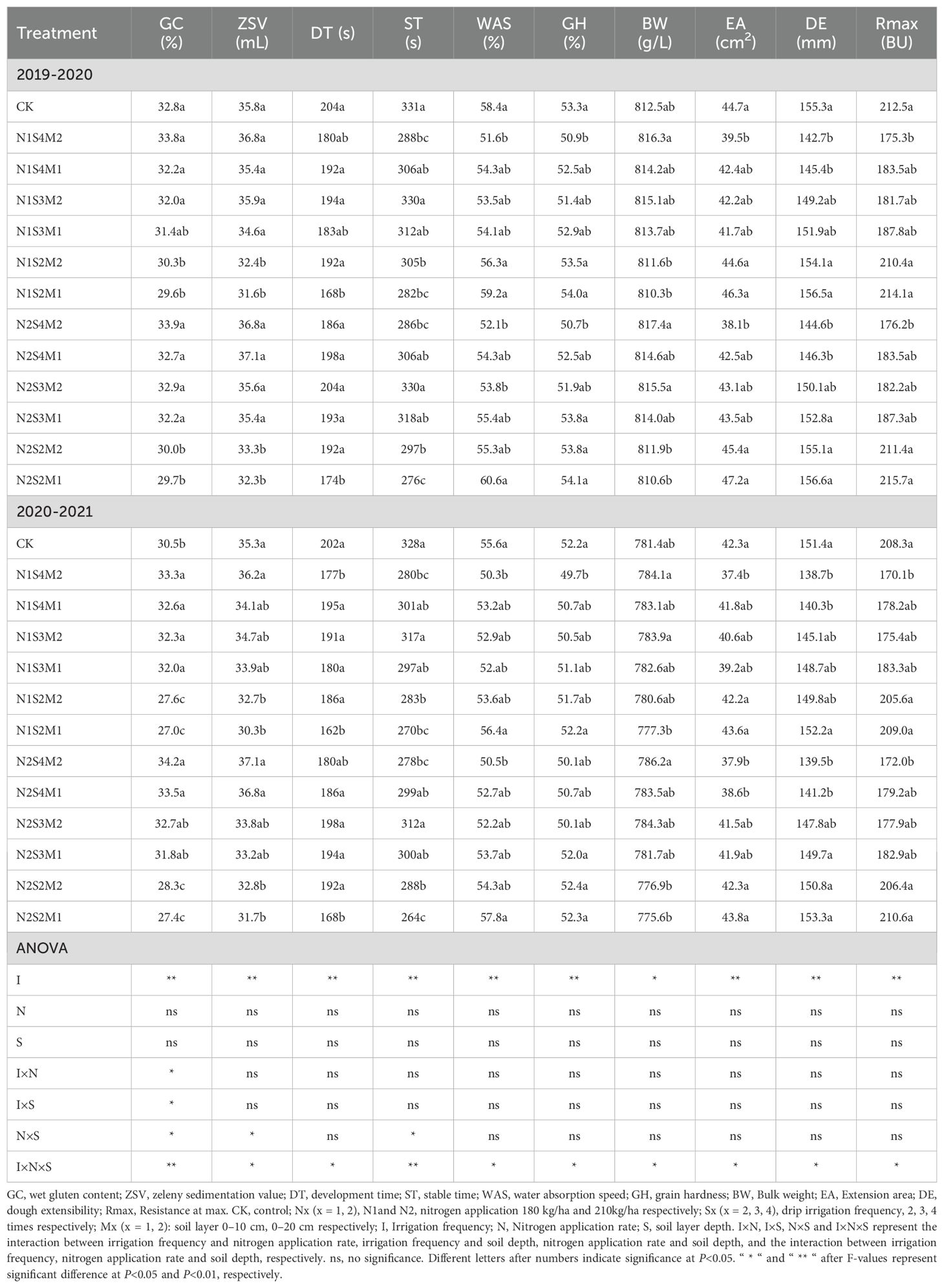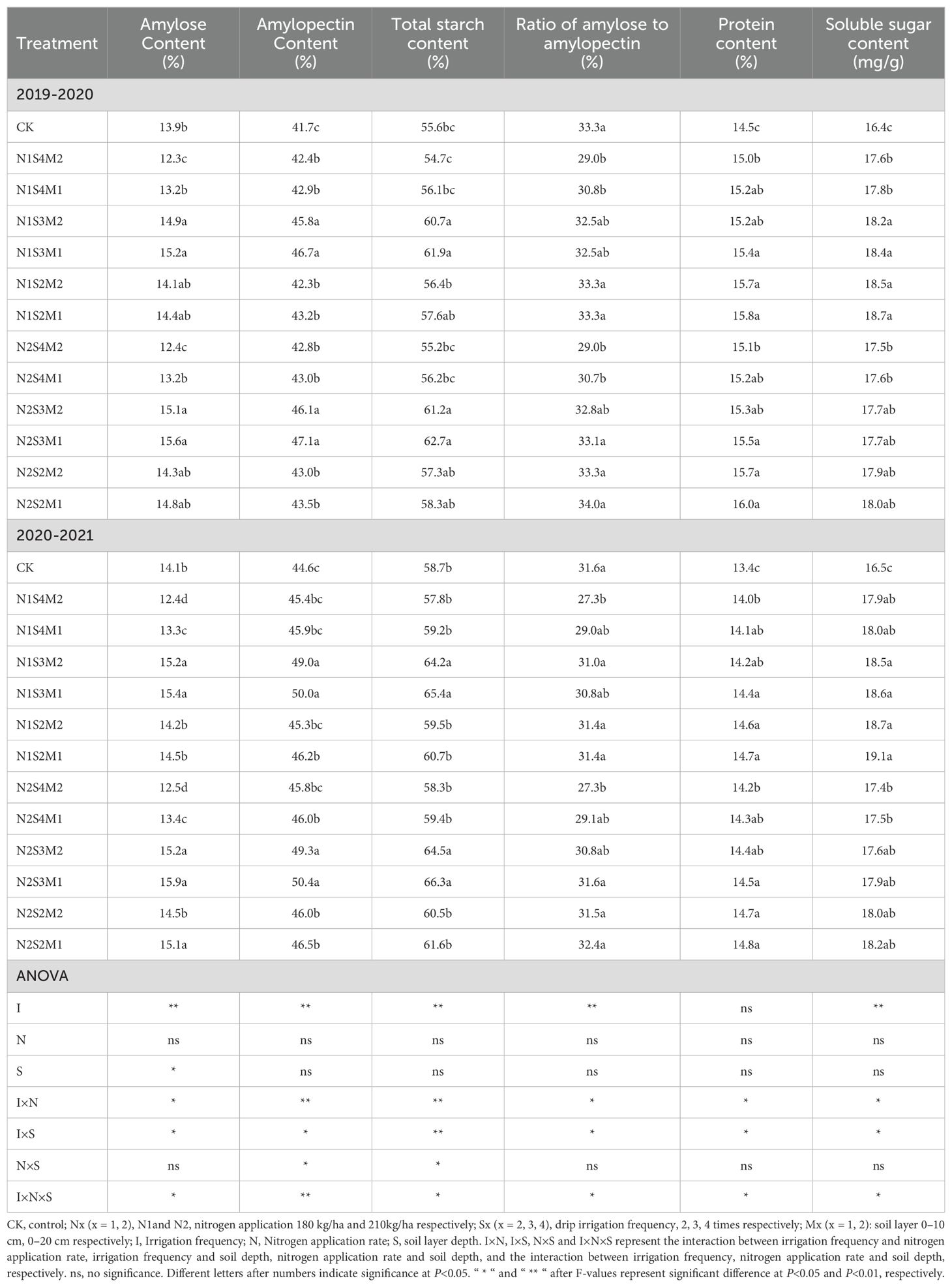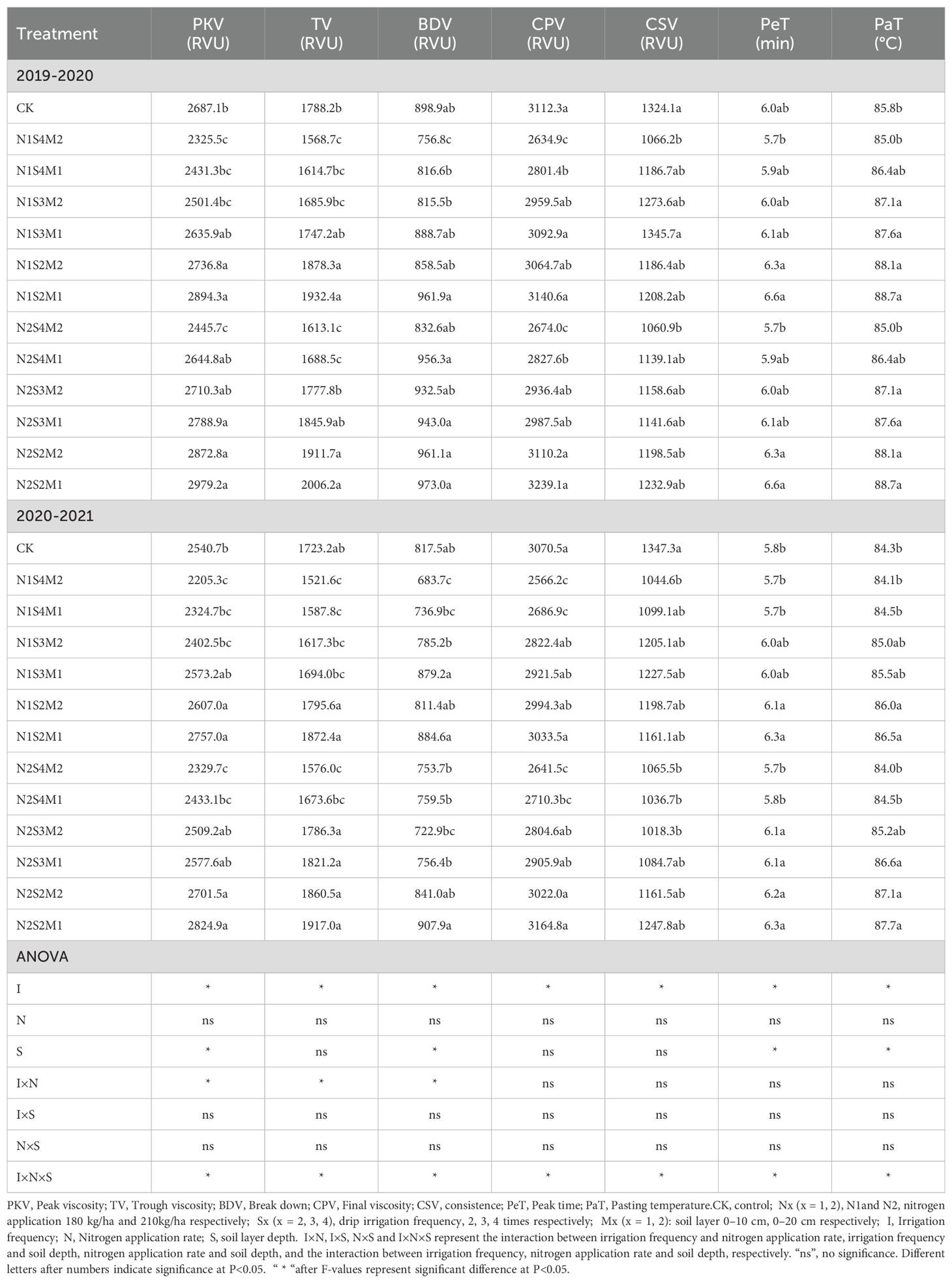- Shandong Provincial Key Laboratory of Dryland Farming Technology, College of Agronomy, Qingdao Agricultural University, Qingdao, China
Introduction: To examine the impacts of varied water and nitroge combinations on wheat yield and quality under drip irrigation in the Huang-Huai-Hai area, a field experiment was conducted over two growing seasons of winter wheat from 2019 to 2021.
Methods: Traditional irrigation and fertilization methods served as the control (CK), with two nitrogen application rates set: N1 (180 kg/ha) and N2 (210 kg/ha). The irrigation schedules were differentiated by growth stages: jointing, anthesis (S2); jointing, anthesis, and filling (S3); and jointing, booting, anthesis, and filling (S4), at soil depths of 0-10 cm (M1) and 0-20 cm (M2).
Results: Results indicated that compared to CK, the 3 and 4 times irrigation treatments comprehensively improved grain yield (GY) by 8.0% and 13.6% respectively, increased the average plant partial factor productivity of nitrogen fertilizer (PFPN) and irrigation use efficiency (IUE) by 57.5% and 38.2%, and 62.2% and 35.8%, respectively. The gluten content (GC) of 3 irrigations was 1.6% higher than CK, and other metrics such as dough tenacity (DT), softness (ST), water absorption (WAS), and gluten hardness (GH) also showed improvements. Furthermore, the contents of amylose, amylopectin, and total starch under 3 irrigations significantly increased by 9.4%, 11.4%, and 9.8%, respectively, with higher than 4 irrigations. The crude protein content and soluble sugar content in 3 irrigations rose by 6.5% and 9.8% respectively over two years. These irrigation treatments also optimized gelatinization characteristics of grains, such as breakdown viscosity (BDV), consistency peak viscosity (CPV), consistency setback viscosity (CSV), pasting temperature (PeT), and pasting time (PaT).
Discussion: The study demonstrated that appropriate drip irrigation can effectively synchronize water and nitrogen supply during critical growth stages in winter wheat, ensuring robust late-stage development and efficient transfer of photosynthetic products into the grains, thus enhancing grain mass and yield. This also led to improved utilization of water and fertilizer and enhanced the nutritional and processing quality of the grain. However, excessive irrigation did not further improve grain quality. In conclusion, given the goals of saving water and fertilizer, achieving excellent yield, and ensuring high quality, the N1S3M1 treatment is recommended as an effective production management strategy in the Huang-Huai Hai area; N1S3M2 could be considered in years of water scarcity.
1 Introduction
Wheat is a primary source of protein and starch in our diet. The wheat output from the Huang-Huai-Hai area constitutes about 70% of the total wheat production in China (Qin et al., 2024). In this region, agricultural water scarcity, insufficient rainfall during the wheat growing season, and challenges with topdressing hinder wheat growth in its later stages, limiting high-quality wheat production (Ding et al., 2017). Local agronomic management practices, such as border irrigation with large amounts of fertilizer, exacerbate water shortages, waste resources, and cause environmental pollution (Hu et al., 2023). Given that the current wheat yield and quality do not meet the demands of daily life, the wheat production target in the Huang-Huai-Hai area has shifted from merely focusing on high and stable yield to improving both yield and quality (Ma et al., 2019). Therefore, exploring high-yield and high-quality dryland wheat cultivation technology is crucial for ensuring grain production security in the Huang-Huai-Hai area.
Reasonable cultivation measures are crucial for controlling the yield and quality of wheat grains (Olga et al., 2022). External nitrogen application effectively promotes nitrogen accumulation, yield, and quality in wheat. External nitrogen application effectively promotes nitrogen accumulation, yield, and quality in wheat (Olga et al., 2018). However, a sole focus on yield has led to indiscriminate nitrogen application, resulting in ineffective tillering, increased soil nitrogen residue, and reduced fertilizer efficiency and utilization rates (Zheng et al., 2020). The interaction between irrigation methods and nitrogen application significantly improves wheat yield and quality (Xin et al., 2023). Rational water and nitrogen management can markedly enhance wheat yield and fertilizer utilization efficiency. Rational water and nitrogen management can markedly enhance wheat yield and fertilizer utilization efficiency (Li et al., 2011). Compared to other irrigation methods, the integration of drip irrigation with water and fertilizer offers significant advantages in saving water and fertilizer, reducing labor, achieving high yield and efficiency, and plays a vital role in high-quality agricultural production and sustainable development in water-scarce regions (Cui et al., 2023; Yao et al., 2023a).
Starch is synthesized by the input of photocontract compounds into the grain as sucrose, catalyzed by a series of enzymes (Hu et al., 2023). Soluble sugar, the substrate for starch synthesis, is closely related to starch accumulation (Qu et al., 2018). Quality indicators such as grain hardness, settling value, wet gluten content, protein content, silty parameters, and tensile parameters are essential for determining wheat use (Ma et al., 2021; Peng et al., 2022). Various amounts and frequencies of water and fertilizer application significantly affect wheat quality and yield. Nitrogen application at the jointing stage promotes nitrogen transfer from vegetative organs to the grain, enhancing grain protein content and improving wheat processing quality. Appropriate nitrogen application significantly increases wheat grain yield, protein content, gluten content, precipitation value, dough stability time, and dough tension. However, excessive nitrogen application reduces grain yield, processing quality, and nutritional quality of wheat (Otteson et al., 2007; Zheng et al., 2018). Early-stage irrigation benefits grain protein accumulation, while reducing irrigation during the middle and late stages increases grain protein content and sedimentation value, prolonging dough formation and stability time (Li et al., 2021). A study for “Jimai 20” which a strong gluten wheat variety, irrigating at the post-anthesis stages significantly improved grain protein content and processing quality. Grain yield, dough formation time, and stability time of irrigation after anthesis were significantly higher than those of subsequent irrigations (Wang et al., 2024). For nitrogen application rates ranging from 0 to 210 kg/ha, wheat grain protein content, wet gluten content, gluten content, and settling value were negatively correlated with irrigation frequency under the same fertilizer application rate (Yao et al., 2023b). Additionally, under 180 kg/ha nitrogen application, GY and water absorption were positively correlated with irrigation frequency, while grain hardness, bulk density, dough stability time, and formation time were negatively correlated (Li et al., 2014). There were also studies that believe winter wheat in North China does not require irrigation in wet years, but irrigation of 60-75 mm at the jointing and heading stages in normal and dry years can significantly improve grain yield and quality (Wang et al., 2006).
Previous studies have yielded a series of results regarding the effects of different amounts of water and fertilizer application on wheat quality and yield. However, environmental factors such as climate, soil’s basic physical and chemical properties, agricultural infrastructure, and production conditions vary across regions, leading to different responses of wheat varieties to water and fertilizer regulation (Sun et al., 2024; Dupont and Altenbach, 2003). Therefore, it remains crucial to thoroughly explore the production benefits of high-yield wheat variety quality and yield under various water and fertilizer management practices. Based on the integrated drip irrigation system of water and fertilizer in the Huang-Huai-Hai area, this experiment investigated deeply the irrigation model for synergistic improvement of wheat quality and yield with supplementary irrigation of water-fertilizer in different key growth periods of wheat by the analysis of soil moisture, aims to provide theoretical support for establishing a wheat cultivation technology system that promotes water and fertilizer savings, high yield, efficiency, and superior quality in the Huang-Huai-Hai area.
2 Materials and methods
2.1 Experimental site description
The experiment was conducted over two growing seasons at the Jiaozhou Modern Agriculture Demonstration Park (35° 53’ N, 119° 58’ E) of Qingdao Agricultural University, spanning from 2019 to 2021. Prior to the cultivation of winter wheat, summer maize was grown during the 2019-2020 and 2020-2021 seasons. The region features a subhumid monsoon climate and the predominant soil type is lime concretion black soil. Details regarding the soil’s organic matter content, pH value, available phosphorus, available potassium, and alkali-hydrolyzed nitrogen in the top 20 cm of soil prior to seeding are detailed in Table 1. Monthly precipitation data for the period is presented in Figure 1.

Table 1. Basic physical and chemical properties of 0-20 cm soil layer of experiment field before sowing.
2.2 Experimental design and crop management
The winter wheat variety “Ji Mai 22” was tested over two growing seasons. Two nitrogen application rates under drip irrigation were established: 180 kg/ha (N1) and 210 kg/ha (N2). The irrigation and fertilization were timed for several growth stages: jointing, anthesis (S2), jointing through filling (S3), and jointing through booting and filling (S4). Two soil layer depths were considered: 0-10 cm (M1) and 0-20 cm (M2). Under N1 and N2, six drip irrigation regimes were configured: S3M1, S3M2, S4M1, S4M2. A traditional border irrigation method served as the control (CK), which involved nitrogen application and irrigation at jointing and anthesis stages, resulting in a total of 13 treatments detailed in Table 2. Under drip irrigation, the average relative water content of the target soil layer was maintained at 100%. Water application was quantified using a water meter, with volumes detailed in Table 3 for different stages.
The experimental field received compound fertilizer (N: P: K= 15:15:15) at the base rates of pure nitrogen, K2O, and P2O5 at 90 kg/ha each, supplemented by equal amounts of urea (46% nitrogen) mixed with irrigation water. The plots, measuring 2.4 m in width, 20 cm row spacing, and extending 60 m in length, were replicated thrice. Drip irrigation tapes were installed in a “one pipe, three rows” configuration with 60 cm between rows to ensure uniform water distribution (Figure 2). Corn straw was mulched back into the field before sowing, which followed tilling and rotating the soil. Sowing occurred on October 14, 2019, and October 10, 2020, with seeding rates of 150 kg/ha and 200 seeds per square meter, respectively. Harvesting was completed on June 16, 2020, and June 19, 2021. All other management practices aligned with those used in high-yield agriculture.
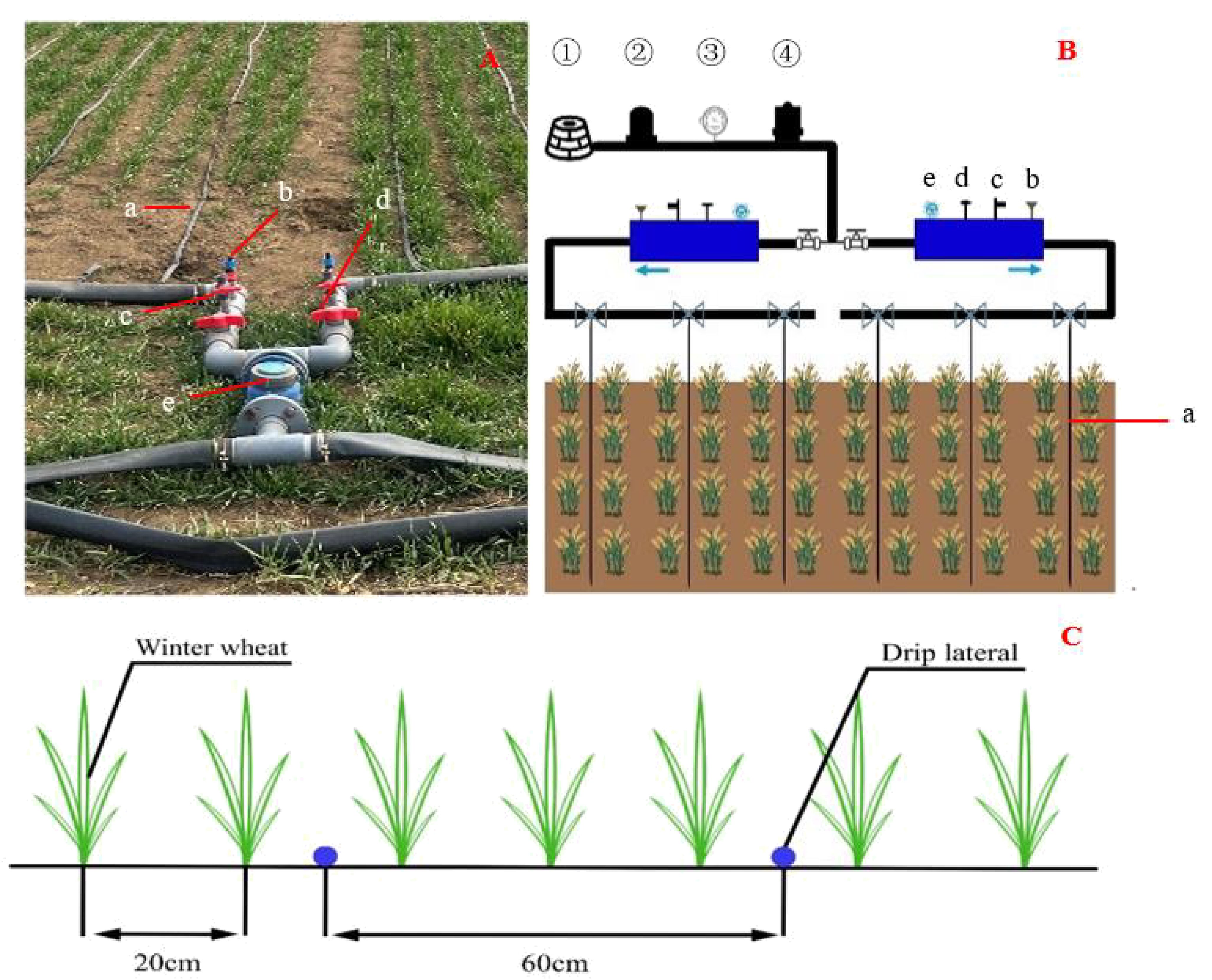
Figure 2. Laying of drip irrigation belts in the field. (A), the actual situation of field drip irrigation system laying; (B), the schematic diagram of drip irrigation belt laying; (C), the parameters of drip irrigation belt laying; a, drip irrigation belt, b, fertilizer inlet, c, exhaust port, d, cut-off valve, e, water meter in (A, B); ①, well, ②, pump,③, pressure gauge, ④, water filter in (B).
2.3 GY and yield components
At the maturity stage of winter wheat, the number of spikes, grains per spike, and the 1000-grain weight were assessed. To measure the yield, a random sample of 12 m² was harvested from each plot. The water content of the grain was determined to be 13.0%.
2.4 Soil moisture content
During each treatment period, soil moisture content in the top 20 cm was measured using the gravimetric method. The calculation for soil gravimetric moisture content (SGMC, %) was expressed as:
Here, SMC and DSM are the soil moisture content and dry soil mass.
2.5 The amount of supplementary irrigation
Soil water storage (SWS, mm) and irrigation volume (IV, Guo et al., 2014) was calculated using the formula:
Where SBD is soil bulk density, ST is soil thickness, SMWC is soil mass water content, DIS is depth of irrigated soil, TWC is target water content, SWCBI is soil water content before irrigation. IUE was calculated as:
2.6 Plant partial factor productivity of nitrogen fertilizer
PFPN was calculated as:
Here, NFAR is nitrogen fertilizer application amount.
2.7 Determination of wheat quality characters and pasting properties
Grain bulk density was measured using the SC6000TR (SC6000TR; Next Instruments, Australia), and grain hardness was assessed with the GWJ-2 hardness tester (GWJ-2; Hangzhou Dacheng Optoelectronic Instrument, China). Wheat grains were crushed using the N9548R mill (N9548R; HODER, China). Soluble sugar content in the wheat grains was quantified by the anthrone colorimetric method (Abid et al., 2018). The total nitrogen content of the wheat grain was analyzed using the Kjeldahl method, applying a grain protein conversion factor of 5.7. Amylose and amylopectin contents were determined via the dual-wavelength method; their combined total represents the overall starch content. Water absorption, dough formation time, and dough stability time were evaluated using the AACC54-21 standard method and a silty meter. The tensile index of flour was measured with a tension meter. The gluten index was determined using the Y07 automatic gluten cleaning instrument, gluten index tester, and Y09 gluten drying instrument (Y07, T08 and Y09; YUCEBAS, Turkey). Finally, the pasting viscosity characteristics of wheat grains were assessed using a Rapid Visco Analyzer (RVA-4; Newport Scientific, Australia).
2.8 Statistical analysis
Experimental results were processed, calculated, analyzed, and visualized using Microsoft Excel 2019 and Origin 2021. Statistical variance analysis (ANOVA) was performed using PASW Statistics 18.0, with significance thresholds set at p = 0.05. Visual representations were created in Origin Pro 2019.
3 Results
3.1 GY, PFPN and IUE
Field tests conducted from 2019 to 2021 (Table 4) revealed that different water and fertilizer schemes did not significantly affect the number of ears or grains per spike in wheat. However, there was a significant increase in 1000-grain weight compared to the CK under the 3 and 4 times irrigation treatments. Compared to CK, the biennial average yield of 3 and 4-irrigation treatments were significantly increased by 8.0% and 13.6%, respectively. PFPN decreased with the adding irrigation frequency and irrigation depth but IUE did the opposite. Compared with CK, PFPN of two-year average of 3 and 4 irrigations increased by 82.8% and 137.1%, and IUE increased by 37.8% and 31.6%, respectively. Overall, 1000-grain weight, GY, PFPN and IUE were significantly influenced by irrigation frequency and its interaction with nitrogen application and soil depth, although nitrogen application alone did not significantly alter these metrics.
3.2 Grain processing quality
Over the two-year wheat growing seasons, as detailed in Table 5, the general trend indicated that the GC and Zeleny Sedimentation Volume (ZSV) of wheat increased with the frequency of irrigation under two nitrogen application rates. The 3and 4 times irrigation treatments increased significantly the two-year averages of GC by 1.6% and 5.1% respectively compared to CK, with no difference in ZSV. According to the performance of DT, ST, water absorption (WAS) and gluten hardness (GH), the processing performance of S4M1, S3M2 and S3M1 is the most stable. The enzyme activity (EA), dough elongation (DE) and maximum resistance (Rmax) decreased with the increase of irrigation frequencies under the same nitrogen application rate and irrigation soil depth under drip irrigation conditions, although the 4-irrigations showed a decrease in some indexes, other drip irrigation treatments still work better compared with CK. Interaction effect analysis revealed that the grain processing quality was significantly influenced by the combined effects of irrigation frequency, nitrogen application gradient, and irrigation depth, whereas the responses to the individual factors of nitrogen gradient and supplementary irrigation depth were minimal.
3.3 Starch and protein dynamics
From 2019 to 2021, as reported in Table 6, the trends for amylose, amylopectin, and total starch content in wheat grains generally increased and then decreased as irrigation frequency intensified across each nitrogen gradient. Specifically, the amylose content and amylopectin content over the two-year average performed best in the 3rd irrigation treatments, significantly increased by 9.4% and 11.4% respectively compared to CK, even the total starch content increased by 9.8%. In terms of the amylose to amylopectin ratio, 3rd irrigation treatments performed relatively stable. Additionally, as irrigation frequency rose, both crude protein and soluble sugar content in drip-irrigated treatments generally decreased, yet remained significantly above CK levels. Over the two-year period, average increases in crude protein and soluble sugar content were 4.9% and 7.4%, 6.5% and 9.8%, and 9.3% and 11.7% respectively compared to CK. The starch, protein, and sugar content in wheat were significantly influenced by the interaction between irrigation frequency, nitrogen application rate, and irrigation depth.
3.4 Gelatinization characteristics
The Table 7 illustrates that the peak viscosity (PKV) and trough viscosity (TV) generally decreased with increasing irrigation frequency. Specifically, the S3M1 treatment remained stable and showed no significant difference compared to the second irrigation treatment. In terms of BDV, the best performance was observed in the N1S4M2 configuration during the 2 times irrigation. For CPV and CSV, the trend showed a decrease from the 2 to the 4 times irrigation treatments. PeT decreased as irrigation frequency increased, with the 2 times irrigation displaying the highest values, 4 times lowest. In two years, the PaT of 2 and 3 times treatments was always significantly differences with CK. Multifactorial interaction analysis indicated that the gelatinization characteristics of wheat grains were primarily influenced by irrigation frequency and its interaction with soil depth and nitrogen application. The effects of soil depth and nitrogen application as singular factors or in combination were not significant.
3.5 Correlation between grain processing quality and gelatinization characteristics
According to a two-year correlation analysis (Figure 3), grain processing quality, gelatinization indices, and protein content demonstrated certain correlations. Notably, wet gluten content, sedimentation value, bulk density, gelatinization temperature, peak time, final viscosity, valley viscosity, and peak viscosity were all significantly negatively correlated. Similarly, disintegration value showed significant negative correlations with wet gluten content, stable time, and crude protein content. Conversely, processing attributes such as water absorption, hardness, tensile area, ductility, and maximum resistance positively correlated with peak time, final viscosity, valley viscosity, and peak viscosity. Additionally, hardness, tensile area, ductility, gelatinization temperature, and disintegration value also exhibited positive correlations. Significant positive correlations were observed between water absorption and both gelatinization temperature and disintegration value; hardness and protein content; tensile area and protein content; ductility and recovery value; and maximum resistance with both gelatinization temperature and disintegration value. No significant correlations were found among other quality indices.
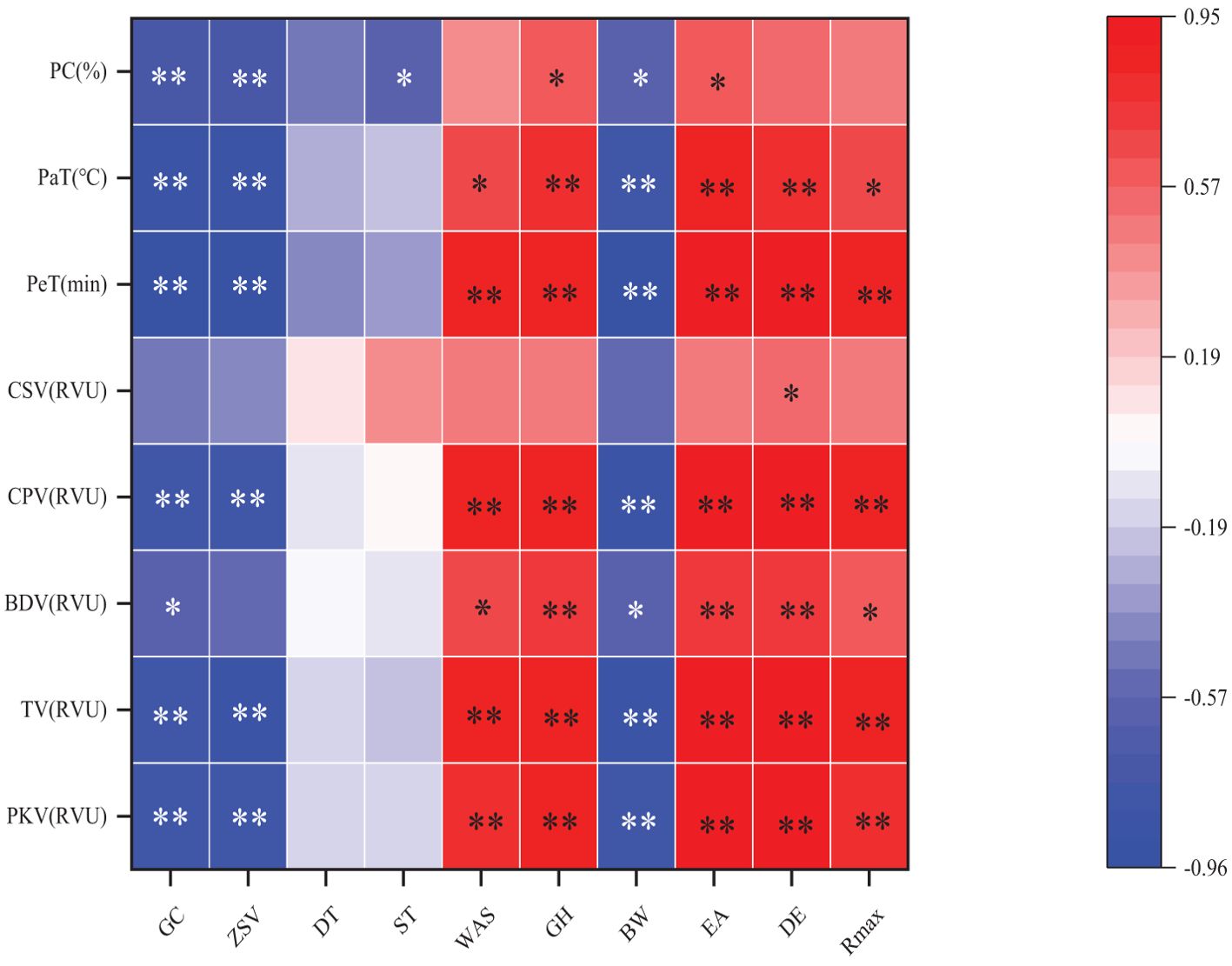
Figure 3. Correlation analysis between grain processing quality and gelatinization characteristics. PKV, Peak viscosity; TV, Trough viscosity; BDV, Break down; CPV, Final viscosity; CSV, consistence; PeT, Peak time; PaT, Pasting temperature, PC, protein content; GC, wet gluten content; ZSV, zeleny sedimentation value; DT, development time; ST, stable time; WAS, water absorption speed; GH, grain hardness; BW, Bulk weight; EA, Extension area; DE, dough extensibility; Rmax, Resistance at max. “ * “ and “ ** “ after F-values represent significant difference at P<0.05 and P<0.01, respectively.
4 Discussion
Irrigation significantly impacts grain yield and quality during the critical growth period. The synergistic application of water and fertilizer across various growth stages enhances their interaction, promoting effective nutrient absorption and contributing to yield formation (Wang et al., 2021). With a nitrogen application rate of 240 kg/ha and irrigation 120 mm from the jointing to filling, both yield and nutrient use efficiency are notably improved, and implementing integrated drip irrigation with 300 kg/ha of nitrogen didn’t result in high yields furthermore (Si et al., 2020). Following a fertilizer application ratio of basal fertilizer: dressing fertilizer = 50%:50% with 240 kg/ha and the relative water content in the 0∼40 cm soil layer was supplemented to 70% in the filled pore space at the jointing and flowering stages increased yield by 5.29∼15.34% (Zhang et al., 2021). Under the total nitrogen application rate of 210 kg/ha, three nitrogen base to topdressing ratios, 1000-grain weight and total protein content were significantly increased by 7.6% and 48.6% (Yao et al., 2023). This study observed no significant changes in panicle and grain numbers per panicle with 3 and 4 drip irrigations compared to CK, but saw substantial increases in thousand-grain weight and average yields over two years by 10.8%, with PFPN gains of 59.9%, IUE was also risen by 38.5% comprehensively, yet no substantial variance was found between the two irrigation levels. Multi-factor analysis indicated that thousand-grain weight, GY, PFPN and IUE were significantly influenced by irrigation frequency, as well as by its interactions with nitrogen application rate and soil depth. These results demonstrate that moderately increasing the irrigation frequency of post-anthesis was conducive to maintaining positive growth conditions of plants, combined with balanced fertilizer applications, enhance wheat’s growth characteristics, optimize environmental conditions for late growth phases, improving the utilization of water and fertilizer by plants, promoting the accumulation of biomass and eventually transferring it to seeds, and finally increasing the quality of seeds, achieving higher yields.
The strategic application of water and fertilizer significantly influences wheat grain yield and quality. Across two nitrogen application gradients, GC and ZSV increased with rising irrigation frequency, with the GC showing a notable 1.6% increase over two years compared to the CK under 3 irrigations treatments. Under consistent nitrogen gradient and irrigation depth, DT and ST initially rose then fell with increasing irrigation frequency, while WAS and GH gradually decreased, but BW increased. Besides, while two irrigation treatments and some indicators in the S4M2 treatment showed declines, other drip irrigation approaches displayed no significant differences from CK. Because the effective water and nitrogen management optimizes the nutrient supply structure, minimizes unproductive and excessive growth, and enhances grain quality by facilitating the transfer and storage of assimilates (Wang et al., 2023). Water scarcity during critical growth periods inhibit the transport of assimilates from vegetative plant parts to ear, especially during the filling, which was also influenced by genetic factors, these seriously affecting wheat settlement value, wet gluten content, and dough stability time (Wang et al., 2005; Tian et al., 2007). Therefore, uniform irrigation during the booting, jointing, anthesis, and filling stages substantially increases wheat bulk density, flour yield, gluten content, and settlement value, and improves several flour tensile properties including stability time, paste temperature, peak time, stretch area, elongation, and grain protein content (Xu et al., 2024). Obviously, the physiological process of dry matter transfer also affects starch content, because amylose and amylopectin, constituting over 65% of the grain’s dry matter, significantly influence processing quality. Research during the wheat filling stage reveals that water and fertilizer treatments markedly impact the soluble sugar and starch content, often showing inverse trends.
Over-irrigation in late growth stages dilutes grain quality (Lv et al., 2021), but total starch contents initially increase with irrigation frequency subsequently decrease, counteracting the negative effects of excessive watering, which can delay ripening and disperse energy needed for reproductive development, reducing starch transfer to grains (Xin et al., 2023; Scofield et al., 2009). Meanwhile, soluble sugars which primarily stored as water-soluble carbohydrates distributed in sucrose form and were crucial for starch synthesis, significantly impacted starch accumulation (Zi et al., 2018). The two-year averages for amylose and amylopectin in three-irrigation treatments rose by 9.4% and 11.4% respectively compared to CK, with total starch increasing by 9.8%. Protein and soluble sugar contents in drip irrigation treatments also showed marked increases over CK, enhancing grain nutrition quality. The above results showed that excessive irrigation, particularly in wet years, may not necessarily boost production and instead adversely affect IUE. Starch gelatinization characteristics—critical for starch application—were also variably affected by irrigation due to differences in starch granule structure among wheat varieties (Xiong et al., 2014). The PKV and TV of treatment S3M1, for example, diminish with increased irrigation. Overall performance trends show that lesser irrigation often outperforms more frequent watering, with significant performance declines noted in the fourth irrigation treatments over two years. These dynamics likely relate to annual precipitation variations, underscoring the influence of rainfall alongside irrigation on wheat quality and nutrient efficiency.
Comprehensive analysis of multifactorial interactions confirms that wheat grain quality is principally shaped by irrigation frequency and its interaction with soil depth and nitrogen levels, though these factors alone are less impactful. Correlation studies further validate the strong links between grain quality, gelatinization properties, and protein content. Given these insights, optimizing drip irrigation schemes is essential for maximizing yield, efficiency, and quality in dryland agriculture, particularly in the Huang-Huai-Hai region, aligning with national food security goals.
5 Conclusion
Analysis of the two-year averages, compared to CK, the sum of 3 and 4 irrigations treatments together significantly improved the GY, PFPN, and IUE respectively by 10.8%, 59.9% and 37.0%, with no significant differences between 3 and 4 irrigations. The GC, DT, ST, WAS, and GH of treatments S4M1, S3M2, and S3M1 outperformed others, amylose, amylopectin, and total starch contents in these three treatments significantly rose by 9.4%, 11.4%, and 9.8%. Meanwhile, 3 and 4 irrigations increased the crude protein and soluble sugar content by 4.9% and 7.4%, 6.5% and 9.8%, respectively, but the performance of 3irrigations in BDV, CPV, CSV, Pet and Pat were more effective than 4 irrigation treatments. In conclusion, 3 times irrigation generally yielded the best overall performance, aligning with the principles of water and fertilizer conservation, excellent yield, and high-quality production. The N1S3M1 treatment is recommended as an efficient management mode for high-yield production in the Huang-Huai-Hai area. Given the ample rainfall during the wheat growing season, N1S3M2 could be adopted in drier years to optimize resource use and crop outcomes.
Data availability statement
The original contributions presented in the study are included in the article/supplementary material. Further inquiries can be directed to the corresponding author.
Author contributions
JZ: Writing – original draft. XX: Writing – review & editing. SL: Data curation, Writing – review & editing. JJ: Writing – review & editing, Methodology. ML: Writing – review & editing, Data curation. HH: Writing – review & editing, Investigation, Data curation. GZ: Writing – review & editing, Formal Analysis, Data curation. CZ: Writing – review & editing, Writing – original draft, Resources, Project administration, Funding acquisition.
Funding
The author(s) declare financial support was received for the research, authorship, and/or publication of this article. Qingdao Science and Technology Benefit for People Demonstration Special Project (24-1-8-xdny-1-nsh); Shandong Province Key Research and Development Plan Project (2022CXPT009); Shandong Province Major Science and Technology Innovation Project (2019JZZY010716); Shandong Province Major Industry Public Relations Project for New and Old Kinetic Energy Conversion (2021-54); Qingdao Modern Agricultural Industry Technology System Wheat Innovation Promotion Team Project (6622316104).
Acknowledgments
Thanks to Junqing Zhang for drawing part B of the Figure 2, who is a undergraduate student from College of Animation Media, Qingdao Agricultural University.
Conflict of interest
The authors declare that the research was conducted in the absence of any commercial or financial relationships that could be construed as a potential conflict of interest.
Publisher’s note
All claims expressed in this article are solely those of the authors and do not necessarily represent those of their affiliated organizations, or those of the publisher, the editors and the reviewers. Any product that may be evaluated in this article, or claim that may be made by its manufacturer, is not guaranteed or endorsed by the publisher.
References
Abid, M., Ali, S., Qi, L., Zahoor, R., Tian, Z., Jiang, D., et al. (2018). Physiological and biochemical changes during drought and recovery periods at tillering and jointing stages in wheat (Triticum aestivum L.). Sci. Rep. 8, 4615. doi: 10.1038/s41598-018-21441-7
Cui, H., Luo, Y., Li, C., Chang, Y., Jin, M., Li, Y., et al. (2023). Effects of nitrogen forms on nitrogen utilization, yield, and quality of two wheat varieties with different gluten characteristics. Eur. J. Agron. 149, 126919. doi: 10.1016/J.EJA.2023.126919
Ding, S. J., Xiong, S. P., Ma, X. M., Zhang, J. J., Wang, X. C., Wu, Y. (2017). Effects of tillage and nitrogen application rate on soil nitrogen transformation and yield in a winter wheat/summer maize multiple cropping system. J. Appl. Ecol. 28, 142–150. doi: 10.13287/j.1001-9332.201701.012
Dupont, F. M., Altenbach, S. B. (2003). Molecular and biochemical impacts of environmental factors on wheat grain development and protein synthesis. J. Cereal Sci. 38, 133–146. doi: 10.1016/S0733-5210(03)00030-4
Guo, Z., Yu, Z., Shi, Y., Zhao, J., Zhang, Y. (2014). Effects of supplemental irrigation by measuring the moisture content at jointing and anthesis on fluorescence characteristics and water use efficiency in flag leaves of wheat. Chin. J. Plant Ecol. 38, 757–766. doi: 10.3724/SP.J.1258.2014.00071
Hu, S., Qiao, B., Yang, Y., Rees, R. M., Huang, W., Zou, J., et al. (2023). Optimizing nitrogen rates for synergistically achieving high yield and high nitrogen use efficiency with low environmental risks in wheat production – evidences from a long-term experiment in the North China Plain. Eur. J. Agron. 142. doi: 10.1016/J.EJA.2022.126681
Li, J., Wang, Z., Yao, C., Zhang, Z., Liu, Y., Zhang, Y. (2021). Micro-sprinkling irrigation simultaneously improves grain yield and protein concentration of winter wheat in the North China. Plain. Crop J. 9, 1397–1407. doi: 10.1016/J.CJ.2020.12.009
Li, Q., Shen, J., Zhao, D. (2011). Effect of irrigation frequency on yield and leaf water use efficiency of winter wheat. Trans. Chin. Soc Agric. Eng. 27, 33–36. doi: 10.3969/j.issn.1002-6819.2011.03.006
Li, Q., Wang, C., Ma, D., Xie, Y., Liu, W., Zhu, Y., et al. (2014). Effects of irrigation and nitrogen application on grain yield, protein content and quality traits of winter wheat in high-yielding area. J. Triticeae Crops 34, 102–107. doi: 10.7606/j.issn.1009-1041.2014.01.17
Lv, X., Ding, Y., Long, M., Liang, W., Gu, X., Liu, Y., et al. (2021). Effect of foliar application of various nitrogen forms on starch accumulation and grain filling of wheat (Triticum aestivum L.) under drought stress. Front. Plant Sci. 12. doi: 10.3389/fpls.2021.645379
Ma, M., Li, Y., Xue, C., Xiong, W., Peng, Z., Han, X., et al. (2021). Current situation and key parameters for improving wheat quality in China. Front. Plant Sci. 12. doi: 10.3389/FPLS.2021.638525
Ma, G., Liu, W., Li, S., Zhang, P., Wang, C., Lu, H., et al. (2019). Determining the optimal N Input to improve grain yield and quality in winter wheat with reduced apparent N Loss in the North China Plain. Front. Plant Sci. 10. doi: 10.3389/fpls.2019.00181
Olga, S. W., Juliet, M., Eva, N., Sanaz, S., Dileepa, J., Chad, J., et al. (2022). Spring wheat yield and grain quality response to nitrogen rate. Agron. J. 114, 2562–2572. doi: 10.1002/AGJ2.21101
Olga, S. W., Sanaz, S., Robin, J. C. (2018). Nitrogen fertilizer management in dryland wheat cropping systems. Plants 7, 9–9. doi: 10.3390/plants7010009
Otteson, N. B., Mergoum, M., Ransom, K. J. (2007). Seeding rate and nitrogen management effects on spring wheat yield and yield components. Agron. J. 99, 1615–1621. doi: 10.2134/agronj2007.0002
Peng, Y., Zhao, Y., Yu, Z., Zeng, J., Xu, D., Dong, J. (2022). Wheat quality formation and its regulatory mechanism. Front. Plant Sci. 13. doi: 10.3389/FPLS.2022.834654
Qin, J., Fan, X., Wang, X., Jiang, M., Lv, M. (2024). Water-use characteristics of wheat–maize Rotation system as affected by nitrogen application rate in North China Plain. Agronomy. 14, 1006. doi: 10.3390/agronomy14051006
Qu, J., Xu, S., Zhang, Z., Chen, G., Zhong, Y., Liu, L., et al. (2018). Evolutionary, structural and expression analysis of core genes involved in starch synthesis. Scientific reports. Sci. Rep. 8, 12736. doi: 10.1038/s41598-018-30411-y
Scofield, G. N., Ruuska, S. A., Aoki, N., Lewis, D. C., Tabe, L. M., Jenkins, C. L. D. (2009). Starch storage in the stems of wheat plants: localization and temporal changes. Ann. BOT-LONDON 103, 859–868. doi: 10.1093/aob/mcp010
Si, Z., Zain, M., Mehmood, F., Wang, G., Gao, Y., Duan, A. (2020). Effects of nitrogen application rate and irrigation regime on growth, yield, and water-nitrogen use efficiency of drip-irrigated winter wheat in the North China Plain. Agr Water Manage 231, 106002–106002. doi: 10.1016/j.agwat.2020.106002
Sun, H., Wang, Y., Wang, L. (2024). Impact of climate change on wheat production in China. Eur. J. Agron. 153, 127066. doi: 10.1016/J.EJA.2023.127066
Tian, J., Hu, R., Deng, Z., Wang, Y. (2007). The variation and stability analysis of wheat dough stability time. Agr Sci. China 6, 143–149. doi: 10.1016/S1671-2927(07)60028-5
Wang, Y., He, X., Li, F., Deng, H., Wang, Z., Huang, C., et al. (2021). Effects of water and nitrogen coupling on the photosynthetic characteristics, yield, and quality of Isatis indigotica. Sci. Rep. 11, 17356–17356. doi: 10.1038/S41598-021-96747-0
Wang, Z., Li, S., Vera, C. L., Malhi, S. S. (2005). Effects of water deficit and supplemental irrigation on winter wheat growth, grain yield and quality, nutrient uptake, and residual mineral nitrogen in soil. Commun. Soil Sci. Plant Anal. 36, 1405–1419. doi: 10.1081/CSS-200058480
Wang, L., Liu, X., Liu, X., Bao, X., Zhang, X., Yin, B., et al. (2024). Effects of spring limited irrigation on grain yield and root characteristics of winter wheat in groundwater-overexploitation areas in the North China Plain. Agr Water Manage 294, 108729. doi: 10.1016/J.AGWAT.2024.108729
Wang, Y., Peng, Y., Lin, J., Wang, L., Jia, Z., Zhang, R. (2023). Optimal nitrogen management to achieve high wheat grain yield, grain protein content, and water productivity: A meta-analysis. Agr Water Manage 290, 108587. doi: 10.1016/J.AGWAT.2023.108587
Wang, S., Zhang, X., Pei, D. (2006). Impacts of different water supplied conditions on root distribution, yield and water utilization efficiency of winter wheat. Trans. Chin. Soc Agric. Eng. 22, 27–32. doi: 10.3321/j.issn:1002-6819.2006.02.007
Xin, L., Fu, Y., Ma, S., Li, C., Wang, H., Gao, Y., et al. (2023). Effects of post-anthesis irrigation on the activity of starch synthesis-related enzymes and wheat grain quality under different nitrogen conditions. Plants 12, 4086. doi: 10.3390/PLANTS12244086
Xiong, F., Yu, X., Zhou, L., Zhang, J., Jin, Y., Li, D., et al. (2014). Effect of nitrogen fertilizer on distribution of starch granules in different regions of wheat endosperm. Crop J. 2, 46–54. doi: 10.1016/j.cj.2013.11.005
Xu, Z., Zhu, W., Wang, L., Shi, F., Wei, Z., Wang, L., et al. (2024). Effects of irrigation and foliar nitrogen application on yield, quality and photosynthetic characteristics of late sowing wheat. Crop J. 40, 139–147. doi: 10.16035/j.issn.1001-7283.2024.02.017
Yao, C., Li, J., Zhang, Z., Liu, Y., Wang, Z., Sun, Z., et al. (2023a). Improving wheat yield, quality and resource utilization efficiency through nitrogen management based on micro-sprinkler irrigation. Agr Water Manage 282, 108277. doi: 10.1016/J.AGWAT.2023.108277
Yao, C., Ren, J., Li, H., Zhang, Z., Wang, Z., Sun, Z., et al. (2023b). Can wheat yield, N use efficiency and processing quality be improved simultaneously. Agr Water Manage 275, 108006. doi: 10.1016/J.AGWAT.2022.108006
Zhang, Z., Yu, Z., Zhang, Y., Shi, Y. (2021). Finding the fertilization optimization to balance grain yield and soil greenhouse gas emissions under water-saving irrigation. Soil Till Res. 214, 105167. doi: 10.1016/J.STILL.2021.105167
Zheng, T., Qi, P., Cao, Y., Han, Y., Ma, H., Guo, Z., et al. (2018). Mechanisms of wheat (Triticum aestivum) grain storage proteins in response to nitrogen application and its impacts on processing quality. Sci. Rep. 8, 11928. doi: 10.1038/s41598-018-30451-4
Zheng, X., Yu, Z., Zhang, Y., Shi, Y. (2020). Nitrogen supply modulates nitrogen remobilization and nitrogen use of wheat under supplemental irrigation in the North China Plain. Sci. Rep. 10, 3305. doi: 10.1038/s41598-020-59877-5
Keywords: winter wheat, drip irrigation, water and nitrogen combination, growth period, grain yield, grain quality
Citation: Zhao J, Xu X, Liu S, Jia J, Li M, Huang H, Zhang G and Zhao C (2024) Optimizing wheat prosperity: innovative drip irrigation and nitrogen management strategies for enhanced yield and quality of winter wheat in the Huang-Huai-Hai region. Front. Plant Sci. 15:1454205. doi: 10.3389/fpls.2024.1454205
Received: 24 June 2024; Accepted: 07 August 2024;
Published: 30 August 2024.
Edited by:
Lorenzo Barbanti, University of Bologna, ItalyReviewed by:
Ana María Mendez-Espinoza, Agricultural Research Institute (Chile), ChileIrshad Ahmad, Northwest A&F University, China
Copyright © 2024 Zhao, Xu, Liu, Jia, Li, Huang, Zhang and Zhao. This is an open-access article distributed under the terms of the Creative Commons Attribution License (CC BY). The use, distribution or reproduction in other forums is permitted, provided the original author(s) and the copyright owner(s) are credited and that the original publication in this journal is cited, in accordance with accepted academic practice. No use, distribution or reproduction is permitted which does not comply with these terms.
*Correspondence: Changxing Zhao, Y3h6aGFvQHFhdS5lZHUuY24=
 Jinke Zhao
Jinke Zhao Xuexin Xu
Xuexin Xu Shuai Liu
Shuai Liu